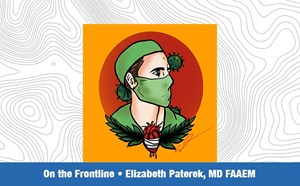Artists Among Us: ACEP's 2021 Annual Report features original art submitted to the 2020 and 2021 HeART of Emergency Medicine Galleries. This piece, "Hail to the Frontline (a series of photo mosaics)" is by Cecile Hollinshead, PA, Michigan Medicine Emergency Department. It was part of a series of photo mosaics taken at the beginning of the COVID 19 pandemic. Pictured here is Fred Korley, MD.
How will we avert potential supply and demand problems to set the specialty up for a bright future? One step at a time.
The future of the emergency medicine workforce has been a hot topic for years now, but it exploded to the surface in March of 2021 with the publication of research commissioned by ACEP and other EM organizations. What may seem like a new initiative actually kicked off in 2017 when leaders raised red flags about the rapid growth rate of the specialty.
Let's take a look at the systematic way ACEP is working to identify and address concerns to ensure the future health of the EM workforce:
- Identify the question. Our specialty has been working for decades to create, evolve, and sustain a workforce that meets the growing emergency medicine needs of our country. In light of growing concerns – but no consensus – about the pace of the specialty’s growth, ACEP believed we needed in-depth research to paint an accurate picture of the future of the EM workforce.
- Bring everyone to the table. In 2018, ACEP invited all of the national EM organizations to participate on a task force to assess the current and future EM workforce and contract with an outside expert to review the literature and existing data on current and projected emergency medicine workforce needs and provide the specialty with an assessment of the future EM workforce. In order to conduct the needed expert analysis, each organization involved contributed to a portion of the total cost of the study, with ACEP funding the majority of the effort and providing staff support to the task force. View the members of the task force.
- Identify the problem. The Emergency Medicine Physician Workforce Task Force contracted with Mr. Edward S. Salsberg, a noted authority on physician workforce, to conduct the data analysis that resulted in The Emergency Medicine Physician Workforce: Projections for 2030. The research, released during a public summit on April 9, 2021, indicated we are facing – for the first time in history – a likely oversupply of emergency physicians in the next decade.
- Seek member feedback. Once the results were shared within the specialty, ACEP opened up a variety of communication channels so that members could weigh in. All feedback was (and continues to be) collected and discussed with the task force that meets regularly to move the project forward.
- Outline next steps. In late Spring 2021, ACEP outlined its framework of workforce considerations that identified key tactics and next steps: 1) Protect the unique role of EM physicians; 2) Ensure comprehensive and consistent EM residency training; 3) Broaden EM physician practice to meet evolving community needs; 4) Support EM physicians and encourage rewarding practice in all communities; 5) Ensure business interests do not supersede needs of educating the workforce.
- Do the work. ACEP firmly believes there is not one ideal, comprehensive solution to industry instability. This is a long-term project, but we must forge ahead with urgency because there are no quick fixes to our challenges. Implementation and change will require the coordinated involvement of the entire specialty, so we are committed to continuing to work together with the multi-organizational task force that conducted the study.
We are working together to solve this supply/demand concern, and we encourage all ACEP members to stay updated and get involved whenever possible.





